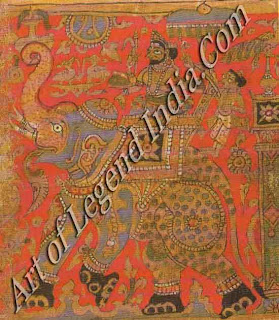 A
remarkable flowering of regional schools of painting took place at the Muslim
and Hindu courts of northern India and the Deccan between the 16th and
19th centuries. Today this enormous production of pictures and illustrated
manuscripts has been largely dispersed by the disinherited princely families
and is found in public and private collections throughout the world. Even to
modern man, living in Babel of visual information, the appeal of Indian
pictures is immediate. They were made above all to delight the eye by their
rich colour harmonies and fluent clarity of line and, by keeping in each case
to a traditional range of expressive conventions, to impart mainly auspicious
or pleasurable sentiments, whether of royal grandeur, devotional wonder or a
refined eroticism. It was an art inseparable from the courtly milieu and its
preoccupations both with religious, literary and musical culture and with the
self-regarding imagery of power and display.
A
remarkable flowering of regional schools of painting took place at the Muslim
and Hindu courts of northern India and the Deccan between the 16th and
19th centuries. Today this enormous production of pictures and illustrated
manuscripts has been largely dispersed by the disinherited princely families
and is found in public and private collections throughout the world. Even to
modern man, living in Babel of visual information, the appeal of Indian
pictures is immediate. They were made above all to delight the eye by their
rich colour harmonies and fluent clarity of line and, by keeping in each case
to a traditional range of expressive conventions, to impart mainly auspicious
or pleasurable sentiments, whether of royal grandeur, devotional wonder or a
refined eroticism. It was an art inseparable from the courtly milieu and its
preoccupations both with religious, literary and musical culture and with the
self-regarding imagery of power and display.
Except
at the Mughal court, where the best of them were un-usually honoured, the
painters themselves were generally artisans of no special status, hereditary
craftsmen who transmitted a continuous tradition which was modified in each
generation as a result of their patron's interest or lack of it in their work.
Stylistic changes can often be related to the personalities of individual
rulers, so far as we know them: they are on the whole better recorded by the
more historically minded Muslim chroniclers than by the Hindu bards and
genealogists.
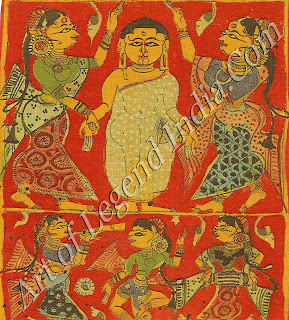
The
medium used by the artists was gouache: mineral, vegetable and animal pigments
mixed with gum arabic, often with embellishment in gold and silver, applied to a
prepared paper or, more rarely, cloth support. At the Muslim courts the finished
work was often mounted within wide paper borders which were ruled and decorated
in gold and colour; Rajput pictures tend to have an integral painted border,
often a bright lacquer red. The whole picture seldom exceeded a size suitable
for holding in the hand. Although Indian paintings are nowadays seen hung
uncompromisingly in rows in galleries, they were not intended for wall display.
In the palaces their designs were sometimes enlarged and coarsened in mural
paintings, of which few early examples survive. Paintings on paper were kept
bound in albums or stacked in cloth-wrapped bundles in libraries or
store-rooms, from which they would be fetched by command, to be appreciatively
inspected at intimate gatherings of nobles or ladies.
An
audience of this kind would have understood naturally the pictorial conventions
employed by artists of their own and neighboring courts, and the densely
interwoven mythological, poetical and musical allusion implicit in their
subject matter. Such resonances could be lost on the modern viewer, who may
also be bewildered by the sheer diversity of the regional court styles
represented in museum collections, with subjects ranging from naturalistic
portraits of rulers and courtiers to farouche depictions of Hindu deities or of
the modes of North Indian music (ragas) personified as gods, princes and
ladies. This diversity reflects above all the differing religious and cultural
traditions of the four principal dynastic and regional centres of patronage.
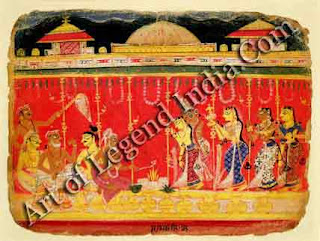 From
the late r6th century the most influential of these was the prolific atelier of
the Muslim Mughal emperors, who dominated northern India from their courts at
Agra, Delhi and Lahore. It was complemented by the distinct traditions
maintained by the independent Muslim sultanates of the Deccan until their
annexation by the Mughal emperor Aurangzeb in the 168os. At the same time, a
great variety of local styles, influenced by Mughal example but fundamentally
indebted to older, indigenous traditions, flourished at the semi-independent
Hindu courts of the Rajputs. These formed two geographically separate groups,
in Rajasthan and Central India to the south and in the Punjab Hills to the
north. If the Rajasthani and Pahari (or 'Hill) schools did not often achieve or
seek the technical refinement of the best Mughal and Deccani painting, they
made up for it both in intensity of feeling and in their greater longevity.
Their relative isolation and closeness to folk roots enabled them to survive
the political disasters of the T 8th century and, in the case of some
Rajasthani schools, to continue into the mid- 9th century, or even later at a
few courts, where the undermining influences of Western art and photography
were for a time success-fully assimilated or ignored.
From
the late r6th century the most influential of these was the prolific atelier of
the Muslim Mughal emperors, who dominated northern India from their courts at
Agra, Delhi and Lahore. It was complemented by the distinct traditions
maintained by the independent Muslim sultanates of the Deccan until their
annexation by the Mughal emperor Aurangzeb in the 168os. At the same time, a
great variety of local styles, influenced by Mughal example but fundamentally
indebted to older, indigenous traditions, flourished at the semi-independent
Hindu courts of the Rajputs. These formed two geographically separate groups,
in Rajasthan and Central India to the south and in the Punjab Hills to the
north. If the Rajasthani and Pahari (or 'Hill) schools did not often achieve or
seek the technical refinement of the best Mughal and Deccani painting, they
made up for it both in intensity of feeling and in their greater longevity.
Their relative isolation and closeness to folk roots enabled them to survive
the political disasters of the T 8th century and, in the case of some
Rajasthani schools, to continue into the mid- 9th century, or even later at a
few courts, where the undermining influences of Western art and photography
were for a time success-fully assimilated or ignored.
Painting Before the Mughal Period
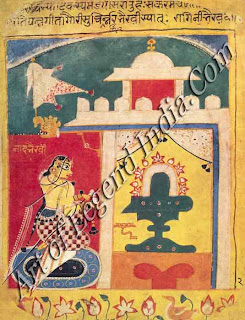 The
painting of India's classical civilization (c.500 BC-1000 AD) has been almost
entirely destroyed by the climate, pests and later Muslim iconoclasm. Early
literary sources describe palaces, houses and temples as being abundantly
decorated with wall-paintings. Painting on wood or cloth was also widely
practised, and picture-making is one of the sixty-four polite arts enjoined on
the cultivated man or woman in the Kama Sutra of Vatsyayana. A glimpse of this
incalculable loss to world art is offered by the remains of wall-paintings at
the Buddhist cave-temples of Ajantamoo BC-500 AD). Their depictions of scenes
from the lives of the Buddha evoke an ideal world, peopled by aristocratic and
serenely graceful gods, men and women living in harmony with nature. The
artists' methods, which included naturalistic techniques of tonal modelling and
spatial recession, are recorded in extant manuals (shilpashastras).
The
painting of India's classical civilization (c.500 BC-1000 AD) has been almost
entirely destroyed by the climate, pests and later Muslim iconoclasm. Early
literary sources describe palaces, houses and temples as being abundantly
decorated with wall-paintings. Painting on wood or cloth was also widely
practised, and picture-making is one of the sixty-four polite arts enjoined on
the cultivated man or woman in the Kama Sutra of Vatsyayana. A glimpse of this
incalculable loss to world art is offered by the remains of wall-paintings at
the Buddhist cave-temples of Ajantamoo BC-500 AD). Their depictions of scenes
from the lives of the Buddha evoke an ideal world, peopled by aristocratic and
serenely graceful gods, men and women living in harmony with nature. The
artists' methods, which included naturalistic techniques of tonal modelling and
spatial recession, are recorded in extant manuals (shilpashastras).
The
later paintings at Ajanta, however, appear to stand at the end of the classical
tradition supported by the Gupta and Vakataka dynasties (fourth and fifth
centuries). In the following centuries a gradual regression occurred from
naturalistic, modelled forms to stylised outline drawing enclosing flat,
decorative colour areas. Something of the graceful quality of Ajanta painting
still remains in the earliest surviving illustrated palm-leaf manuscripts,
produced in the scriptoria of the great Buddhist teaching monasteries of
eastern India under the Pala dynasty in the 11th and 12th
centuries. Paintings of the Buddhas or of associated deities, either wrathful
or benign like the compassionate goddess Tara plate were introduced into the
sublimely metaphysical Buddhist wisdom texts not for illustration but for the
protection of the owner and the manuscript.
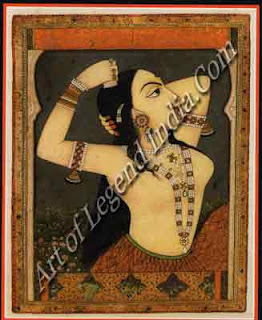 From
the early 13th century northern India was overrun by Turks and
Afghans from Central Asia, who established Muslim: dominance over all but the
far south of the sub-continent. With the destruction of the monasteries,
Buddhist culture all but disappeared in its homeland, and the Pala tradition
was carried on only in Nepal and Tibet. Hindu religious and secular culture
also suffered from the removal of royal patronage. The culture of the Muslim
sultans was Persian, and their taste in painting extended only to manuscript
illustration in Persianatc styles. During these lean early centuries of Muslim
rule, the native tradition of painting was largely kept alive by members of the
wealthy merchant classes of western India who were devotees of Jainism, an
ascetically inclined religion founded by Mahavira, a near-contemporary of the
Buddha, in the 6th century BC. Prosperous Jain laymen commonly
sought religious merit by commissioning illustrated copies of sacred texts for
presentation to monastic libraries. Huge numbers of stereotyped and sometimes
gaudily opulent series of illustrations were thus produced.
From
the early 13th century northern India was overrun by Turks and
Afghans from Central Asia, who established Muslim: dominance over all but the
far south of the sub-continent. With the destruction of the monasteries,
Buddhist culture all but disappeared in its homeland, and the Pala tradition
was carried on only in Nepal and Tibet. Hindu religious and secular culture
also suffered from the removal of royal patronage. The culture of the Muslim
sultans was Persian, and their taste in painting extended only to manuscript
illustration in Persianatc styles. During these lean early centuries of Muslim
rule, the native tradition of painting was largely kept alive by members of the
wealthy merchant classes of western India who were devotees of Jainism, an
ascetically inclined religion founded by Mahavira, a near-contemporary of the
Buddha, in the 6th century BC. Prosperous Jain laymen commonly
sought religious merit by commissioning illustrated copies of sacred texts for
presentation to monastic libraries. Huge numbers of stereotyped and sometimes
gaudily opulent series of illustrations were thus produced.
The
regression towards a linear, conceptual mode of representation was now
complete. One of the characteristic features of the style is the protrusion
into space of the further eye of the human face seen in profile. Nevertheless,
their wiry drawing, simplified colour schemes and profuse detail can give Jain
paintings an energy and charm of their own. The schematic and literal-minded
approach of the artists to their subject matter is seen in a lively
illustration, divided into upper and lower registers, of the ideally chaste
monk, who is unmoved by the beguilements of women.
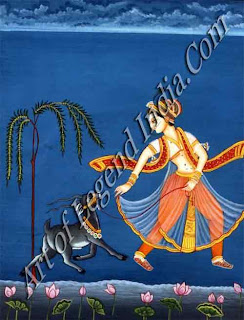 Jain
patronage thus preserved intact elements of a native style, which were by the
early 16th century to be revivified by artists working in a new and more
expressive idiom. During the 15th century a resurgence of popular
Hindu devotional cults had occurred throughout northern India, centred on the
incarnations of Vishnu as the hero Rama and, more particularly, as Krishna, the
youthful, dark-skinned cowherd god. Krishna's mythical exploits during his
childhood and youth spent in a village in the Braj country near Mathura
included the slaying of many demons and a tyrant king as well as various love
sports with the local milkmaids, among whom Radha became a preeminent figure.
Jain
patronage thus preserved intact elements of a native style, which were by the
early 16th century to be revivified by artists working in a new and more
expressive idiom. During the 15th century a resurgence of popular
Hindu devotional cults had occurred throughout northern India, centred on the
incarnations of Vishnu as the hero Rama and, more particularly, as Krishna, the
youthful, dark-skinned cowherd god. Krishna's mythical exploits during his
childhood and youth spent in a village in the Braj country near Mathura
included the slaying of many demons and a tyrant king as well as various love
sports with the local milkmaids, among whom Radha became a preeminent figure.
These episodes were celebrated in devotional verse in the Sanskrit and
vernacular literatures, and they also came to be represented in a vigorous,
widespread style of manuscript illustration. The patrons of this new
development appear to have been both the Vaishnavite merchant classes of the
Mathura region and, at a more refined level of production, the still
independent Hindu courts of the Rajputs, who had resisted Muslim incursions and
continued to rule the adjoining regions of Rajasthan and Central India. A page
from the most lively and inventive of the surviving manuscripts in the style
shows an enhanced spatial sense and fluency of drawing and a use of glowing colour
to create an atmosphere of elation appropriate to its subject, Krishna's
parents are shown standing before the sacrificial fire, on which the priest who
is marrying them pours ghee, while female attendants and male guests look on.
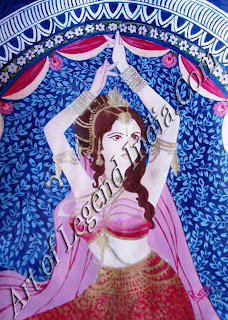 As
patrons of learning, literature, music and art, the Rajput rulers also
preserved and developed the secular traditions of classical Indian culture.
Manuscript illustrations of poetical texts were produced in the same style as
the devotional themes, and the two streams were in fact largely
indistinguishable.
As
patrons of learning, literature, music and art, the Rajput rulers also
preserved and developed the secular traditions of classical Indian culture.
Manuscript illustrations of poetical texts were produced in the same style as
the devotional themes, and the two streams were in fact largely
indistinguishable.
Down to the 19th century, Krishna subjects in
particular became closely associated with the imagery of poetical and
rhetorical works. Displaying the Indian passion for minute classification,
these enumerated the many different types of male and female lovers and their
emotional states, or, in the case of ragantala texts, evoked the essential
character of the ragas or musical modes in images of gods, ascetics, nobles,
ladies and animals in specific attitudes and configurations. In one of the
earliest surviving ragantala pictures the mode Bhairavi is described in the
verses above as a lady of fair complexion who worships Shiva in his litigant
(phallic) form with flowers, songs and cymbal accompaniment at a lakeside temple
near the sacred Mount Kailasa's As so often in Rajput pictures, there is a
mingling of the devotional and erotic sentiments, hinted at by the temple
finial in the form of a flag-bearing inakara, a mythical aquatic beast
emblematic of the love-god Kama.
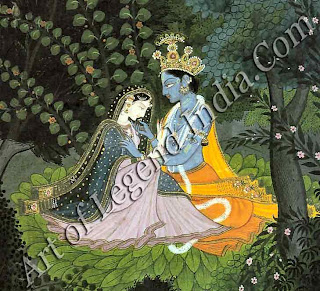
In its allusive subject matter, bold drawing
and juxtaposition of broad areas of pure colour, this style of painting
anticipates the later work of the Rajasthani and Central Indian schools, whose
individual histories only begin to be clear from the early 17th century
onwards. However, their continuity from the earlier style is difficult to trace
precisely, for from the late 16th century Rajput patronage was both disrupted
and modified by the coming of the Mughals, the last and most powerful of the
Muslim dynasties of northern India.
Writer – Andrew Topsfield
 A
remarkable flowering of regional schools of painting took place at the Muslim
and Hindu courts of northern India and the Deccan between the 16th and
19th centuries. Today this enormous production of pictures and illustrated
manuscripts has been largely dispersed by the disinherited princely families
and is found in public and private collections throughout the world. Even to
modern man, living in Babel of visual information, the appeal of Indian
pictures is immediate. They were made above all to delight the eye by their
rich colour harmonies and fluent clarity of line and, by keeping in each case
to a traditional range of expressive conventions, to impart mainly auspicious
or pleasurable sentiments, whether of royal grandeur, devotional wonder or a
refined eroticism. It was an art inseparable from the courtly milieu and its
preoccupations both with religious, literary and musical culture and with the
self-regarding imagery of power and display.
A
remarkable flowering of regional schools of painting took place at the Muslim
and Hindu courts of northern India and the Deccan between the 16th and
19th centuries. Today this enormous production of pictures and illustrated
manuscripts has been largely dispersed by the disinherited princely families
and is found in public and private collections throughout the world. Even to
modern man, living in Babel of visual information, the appeal of Indian
pictures is immediate. They were made above all to delight the eye by their
rich colour harmonies and fluent clarity of line and, by keeping in each case
to a traditional range of expressive conventions, to impart mainly auspicious
or pleasurable sentiments, whether of royal grandeur, devotional wonder or a
refined eroticism. It was an art inseparable from the courtly milieu and its
preoccupations both with religious, literary and musical culture and with the
self-regarding imagery of power and display.  From
the late r6th century the most influential of these was the prolific atelier of
the Muslim Mughal emperors, who dominated northern India from their courts at
Agra, Delhi and Lahore. It was complemented by the distinct traditions
maintained by the independent Muslim sultanates of the Deccan until their
annexation by the Mughal emperor Aurangzeb in the 168os. At the same time, a
great variety of local styles, influenced by Mughal example but fundamentally
indebted to older, indigenous traditions, flourished at the semi-independent
Hindu courts of the Rajputs. These formed two geographically separate groups,
in Rajasthan and Central India to the south and in the Punjab Hills to the
north. If the Rajasthani and Pahari (or 'Hill) schools did not often achieve or
seek the technical refinement of the best Mughal and Deccani painting, they
made up for it both in intensity of feeling and in their greater longevity.
Their relative isolation and closeness to folk roots enabled them to survive
the political disasters of the T 8th century and, in the case of some
Rajasthani schools, to continue into the mid- 9th century, or even later at a
few courts, where the undermining influences of Western art and photography
were for a time success-fully assimilated or ignored.
From
the late r6th century the most influential of these was the prolific atelier of
the Muslim Mughal emperors, who dominated northern India from their courts at
Agra, Delhi and Lahore. It was complemented by the distinct traditions
maintained by the independent Muslim sultanates of the Deccan until their
annexation by the Mughal emperor Aurangzeb in the 168os. At the same time, a
great variety of local styles, influenced by Mughal example but fundamentally
indebted to older, indigenous traditions, flourished at the semi-independent
Hindu courts of the Rajputs. These formed two geographically separate groups,
in Rajasthan and Central India to the south and in the Punjab Hills to the
north. If the Rajasthani and Pahari (or 'Hill) schools did not often achieve or
seek the technical refinement of the best Mughal and Deccani painting, they
made up for it both in intensity of feeling and in their greater longevity.
Their relative isolation and closeness to folk roots enabled them to survive
the political disasters of the T 8th century and, in the case of some
Rajasthani schools, to continue into the mid- 9th century, or even later at a
few courts, where the undermining influences of Western art and photography
were for a time success-fully assimilated or ignored.  The
painting of India's classical civilization (c.500 BC-1000 AD) has been almost
entirely destroyed by the climate, pests and later Muslim iconoclasm. Early
literary sources describe palaces, houses and temples as being abundantly
decorated with wall-paintings. Painting on wood or cloth was also widely
practised, and picture-making is one of the sixty-four polite arts enjoined on
the cultivated man or woman in the Kama Sutra of Vatsyayana. A glimpse of this
incalculable loss to world art is offered by the remains of wall-paintings at
the Buddhist cave-temples of Ajantamoo BC-500 AD). Their depictions of scenes
from the lives of the Buddha evoke an ideal world, peopled by aristocratic and
serenely graceful gods, men and women living in harmony with nature. The
artists' methods, which included naturalistic techniques of tonal modelling and
spatial recession, are recorded in extant manuals (shilpashastras).
The
painting of India's classical civilization (c.500 BC-1000 AD) has been almost
entirely destroyed by the climate, pests and later Muslim iconoclasm. Early
literary sources describe palaces, houses and temples as being abundantly
decorated with wall-paintings. Painting on wood or cloth was also widely
practised, and picture-making is one of the sixty-four polite arts enjoined on
the cultivated man or woman in the Kama Sutra of Vatsyayana. A glimpse of this
incalculable loss to world art is offered by the remains of wall-paintings at
the Buddhist cave-temples of Ajantamoo BC-500 AD). Their depictions of scenes
from the lives of the Buddha evoke an ideal world, peopled by aristocratic and
serenely graceful gods, men and women living in harmony with nature. The
artists' methods, which included naturalistic techniques of tonal modelling and
spatial recession, are recorded in extant manuals (shilpashastras).  From
the early 13th century northern India was overrun by Turks and
Afghans from Central Asia, who established Muslim: dominance over all but the
far south of the sub-continent. With the destruction of the monasteries,
Buddhist culture all but disappeared in its homeland, and the Pala tradition
was carried on only in Nepal and Tibet. Hindu religious and secular culture
also suffered from the removal of royal patronage. The culture of the Muslim
sultans was Persian, and their taste in painting extended only to manuscript
illustration in Persianatc styles. During these lean early centuries of Muslim
rule, the native tradition of painting was largely kept alive by members of the
wealthy merchant classes of western India who were devotees of Jainism, an
ascetically inclined religion founded by Mahavira, a near-contemporary of the
Buddha, in the 6th century BC. Prosperous Jain laymen commonly
sought religious merit by commissioning illustrated copies of sacred texts for
presentation to monastic libraries. Huge numbers of stereotyped and sometimes
gaudily opulent series of illustrations were thus produced.
From
the early 13th century northern India was overrun by Turks and
Afghans from Central Asia, who established Muslim: dominance over all but the
far south of the sub-continent. With the destruction of the monasteries,
Buddhist culture all but disappeared in its homeland, and the Pala tradition
was carried on only in Nepal and Tibet. Hindu religious and secular culture
also suffered from the removal of royal patronage. The culture of the Muslim
sultans was Persian, and their taste in painting extended only to manuscript
illustration in Persianatc styles. During these lean early centuries of Muslim
rule, the native tradition of painting was largely kept alive by members of the
wealthy merchant classes of western India who were devotees of Jainism, an
ascetically inclined religion founded by Mahavira, a near-contemporary of the
Buddha, in the 6th century BC. Prosperous Jain laymen commonly
sought religious merit by commissioning illustrated copies of sacred texts for
presentation to monastic libraries. Huge numbers of stereotyped and sometimes
gaudily opulent series of illustrations were thus produced.  Jain
patronage thus preserved intact elements of a native style, which were by the
early 16th century to be revivified by artists working in a new and more
expressive idiom. During the 15th century a resurgence of popular
Hindu devotional cults had occurred throughout northern India, centred on the
incarnations of Vishnu as the hero Rama and, more particularly, as Krishna, the
youthful, dark-skinned cowherd god. Krishna's mythical exploits during his
childhood and youth spent in a village in the Braj country near Mathura
included the slaying of many demons and a tyrant king as well as various love
sports with the local milkmaids, among whom Radha became a preeminent figure.
Jain
patronage thus preserved intact elements of a native style, which were by the
early 16th century to be revivified by artists working in a new and more
expressive idiom. During the 15th century a resurgence of popular
Hindu devotional cults had occurred throughout northern India, centred on the
incarnations of Vishnu as the hero Rama and, more particularly, as Krishna, the
youthful, dark-skinned cowherd god. Krishna's mythical exploits during his
childhood and youth spent in a village in the Braj country near Mathura
included the slaying of many demons and a tyrant king as well as various love
sports with the local milkmaids, among whom Radha became a preeminent figure.  As
patrons of learning, literature, music and art, the Rajput rulers also
preserved and developed the secular traditions of classical Indian culture.
Manuscript illustrations of poetical texts were produced in the same style as
the devotional themes, and the two streams were in fact largely
indistinguishable.
As
patrons of learning, literature, music and art, the Rajput rulers also
preserved and developed the secular traditions of classical Indian culture.
Manuscript illustrations of poetical texts were produced in the same style as
the devotional themes, and the two streams were in fact largely
indistinguishable. 












Thanks for sharing about Traditional Painting. Your content is realy informative for us......
Indian Traditional Paintings
Indian Painting
Traditional Paintings
Traditional Painting
Indian Traditional Painting
Traditional Paintings
Traditional Painting